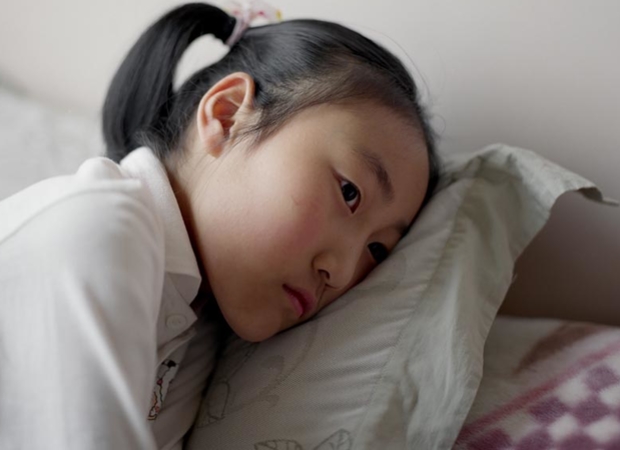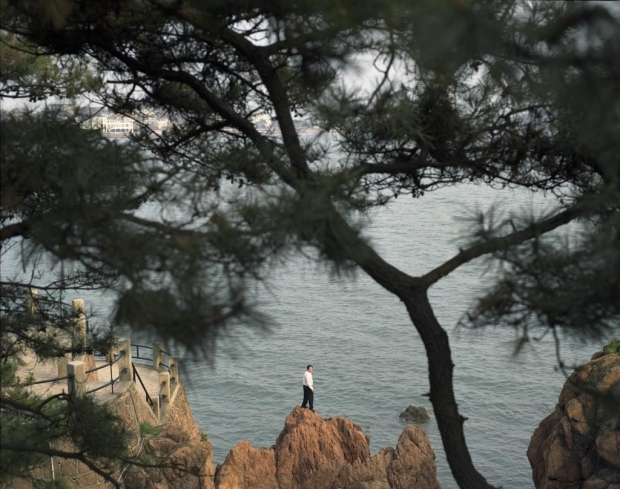When Shen Wei was growing up in Shanghai during the nineteen-eighties and nineties, his mother worked as a fashion designer who specialized in calendars. If a company wanted to publish one, they hired Shen Wei’s mother, and she designed clothes for a model to wear during the photo shoot. In those days, virtually every Chinese home and business displayed at least one calendar, and there was an entire industry of fashion designers, models, photographers, and publishers, all of them working to create these month-to-month images.
In the mid-nineties, I was a Peace Corps teacher in Fuling, a small city in Southwestern China. Whenever I visited friends, their calendars caught my eye because there weren’t many other large photographs in homes. People sometimes pinned small family snapshots to the walls, but there was no concept of art photography—I never saw a nicely framed print or a book of photos by an artist. Home decorations tended to be sparse; at the time, few Chinese owned their apartments, which were usually administered by the danwei, or work unit. Paint was institutional: in my six-story building, you saw the same light-green color on every wall of every apartment. Floors were bare concrete; nobody had carpeting. Any resident fortunate enough to own a new couch kept it wrapped in clear plastic to protect against dust.
The calendars, though, were windows into a different world. They had bright colors, sharp reds and deep greens and the kinds of blues that existed far above our own coal-stained skies. Sometimes a single model graced every page, smiling her way from January to December, but there wasn’t a seasonal element to the portraits: the February xiaojie might have bare shoulders, and then in June she’d wear a heavy silk shawl. The women existed outside of time, and place was also indeterminate. A model might lean against a faux Roman pillar, or maybe she’d stand in front of a red-roofed house that looked vaguely European. As a series of images the calendars seemed incoherent, but that wasn’t the point—these were portraits of feelings. They captured a sense of yearning that you felt in almost every Chinese home at that time.
Culture
11.22.13
A Homecoming
It was surprising how comfortable these living spaces were. A Chinese home was far more than the sum of its parts, because intangibles like sound and scent were part of the decor. People rarely ate out in restaurants, and their homes smelled strongly of the Sichuanese chili pepper and huajiao spice they used in cooking. They didn’t have air-conditioning or good heat, so they kept their windows open, and you heard the everyday hum of neighboring conversations and street noises. Residents still spent hours outdoors; local parks felt as familiar as living rooms. It wasn’t until later that I realized how unique this moment was, and how delicately it stood poised between two very different ways of life. For the first time, most Chinese were no longer poor, and they were hopeful about the future; but they had yet to insulate themselves with the trappings of material success. Their dreams were as wide-open and sentimental as the portraits on their calendars.
In big cities the transition to prosperity happened so fast that it was rarely documented. Old neighborhoods were razed, replaced by high-rises with weather-sealed windows, and outdoor life became distant. Former luxuries—televisions, refrigerators, comfortable furniture—were now standard. The new goal was to buy a car, but soon even that was easy: by 2001, Beijing gained an average of nearly a thousand new drivers every day. And life moved too fast for feelings like nostalgia or regret. “Everybody was so happy we were moving out of the slum, and nobody cared what was in it,” Shen Wei says now, remembering his old Shanghai home. “You moved out without looking back. Nobody took pictures. There were no records of it. This is my biggest regret, because now I think about my childhood in the slum, and it was quite happy. It was very different from growing up in a skyscraper. You ate outside, you played outside, you slept outside in the summer.”
Shen’s mother retired from fashion design in 2003, and the calendar industry as she knew it no longer exists. “People in the city don’t keep calendars like that anymore,” Shen says. Even in rural China, where you still see them displayed prominently, the pictures tend to be different. The last time I visited a farming home north of Beijing, the family’s calendar featured photos of infrastructure projects from around the region. These images were literal, with detailed captions: the new Beijing to Chengde Expressway, an aerial shot of the city of Huairou, a concrete roundabout south of downtown. The photographs had few people and even less mystery. The main thing you noticed was all the cars.
“I never touched a camera before I went to America, in 2000,” Shen Wei says. “In China there was not such a thing as fine-art photography. You went to a gallery and it was all paintings. It was an abstract thing to me; I really knew nothing about the art world outside of China.” Shen grew up in an artistic family; in addition to his mother, both his aunt and his uncle worked as artists. But after middle school, Shen enrolled in a vocational school that specialized in hotel services. He was assigned to the Blue Sky Hotel, where he worked as a waiter. It was his first experience of life outside of the old neighborhood. “The people who stayed there came from all over China,” he says. “I would look at them and wonder what kind of lives they had.” He hated working at the Blue Sky, but a manager noticed his artistic talent and had him design the boards that advertised the daily dinner specials. “Those assignments were an escape,” he says. “I’d do it as slowly as I could.”
After more than two years in hotel services, Shen attended Shanghai Light Industry College, where his specialty was packaging design. For a few years he worked as a freelancer, undertaking the motley assignments that were available in China during the late nineties. “I designed a lot of catalogs for the police,” he says. “If the police came up with new regulations for shipping companies, they’d print ten thousand catalogs. I designed some of them.” He created posters for a Peking opera troupe. He designed shopping bags for the Peace Hotel. He worked for Coca-Cola and United Airlines. He created a set of drink coasters, each of which featured a map of Shanghai from a different decade. The twenties, the thirties, the forties—every drink on the table sat on its own version of the ever-changing city.
The money was good, but the work never felt meaningful. “I did design as a job,” he says. “I didn’t put my soul into it.” In 2000, he enrolled at the Minneapolis College of Art and Design, where he hoped to become a painter. But his plans changed after he took a required introductory class in photography. “I took two photo classes, and I was so inspired by the medium that I decided I wanted to become a photographer.”
Over the next decade, Shen learned photography and established himself in New York City. He rarely returned to China, and he dedicated his efforts to a series of photographs that explored identity and sexuality in America. He eventually entitled that project “Almost Naked,” and in 2008 he returned to China and gave a lecture about his work at People’s University in Beijing. He found the experience profoundly disorienting. “It was very hard for me to explain things, especially photography, because I had learned everything in English,” he says. “I had a hard time explaining it in Chinese. And I was constantly getting lost in what I was seeing, because everything was new.”
Shen began making long trips to China, where he reconnected with the culture, learning a new vocabulary that allowed him to describe his art. And he began to apply the photographic skills that he had learned in America to his homeland, taking portraits in provincial cities like Chengdu, Guilin, and Wuhan. He rarely photographed Shanghai and Beijing, because they were already so developed. In the nation’s interior, where the transformation wasn’t yet complete, he could still find traces of the China he remembered from childhood. “I started to look back to old things, to things I grew up with,” Shen says. “Things that at the time didn’t seem so important.”
There are almost no automobiles in this book. There aren’t any factories or assembly lines. We don’t see vast mobs of people, or overwhelming traffic scenes, or the army-like crews of uniformed workers that have become standard in the foreign imagery of today’s China. These are quiet, personal pictures, and they often have an early-morning feel, those hazy hours when Chinese people traditionally enjoy being outdoors. A large number of photographs feature the private side of public parks. Green is a common color. And water is everywhere—canals and rivers and lakes, the slate-gray surface a slightly deeper shade than the sky. There was a time when the life of Chinese cities revolved around waterways rather than roads, and it was recent enough that even a thirty-year-old photographer can recall it with nostalgia.
Often the people in these photographs are solitary. Many are strangers who agreed to pose for Shen as he passed through town, and he shot them in their homes and neighborhoods. In a number of pictures, an individual stands on the periphery of some expansive scene—a wintry park, a placid lake, a misty mountain. With these images, the sense of the past runs far deeper than a young man’s memory. It connects with the millennia-old tradition of Chinese landscape painting, where balance is perfect and tiny figures teeter at the edge of sweeping vistas. During his years in America, living in Minneapolis and New York, Shen often recalled the Li Bai poem “Quiet Night Thoughts.” Written over a thousand years ago, the poem captures the author’s homesickness in twenty spare characters.
“Every time I think about this poem, I think about all those Chinese paintings of the Yellow Mountains, with the little people in the mountains,” Shen says. “It’s almost like a fantasy, to live in the ancient times. People living in the mountains, living on the water, drinking wine and writing poetry. This is a kind of dream, my dream of life. I often think if there’s a dynasty in China I want to go back to, it’s the Tang dynasty.”
Before my bed there is bright moonlight
So that it seems like frost on the ground:
Lifting my head I watch the bright moon,
Lowering my head I dream that I’m home.




